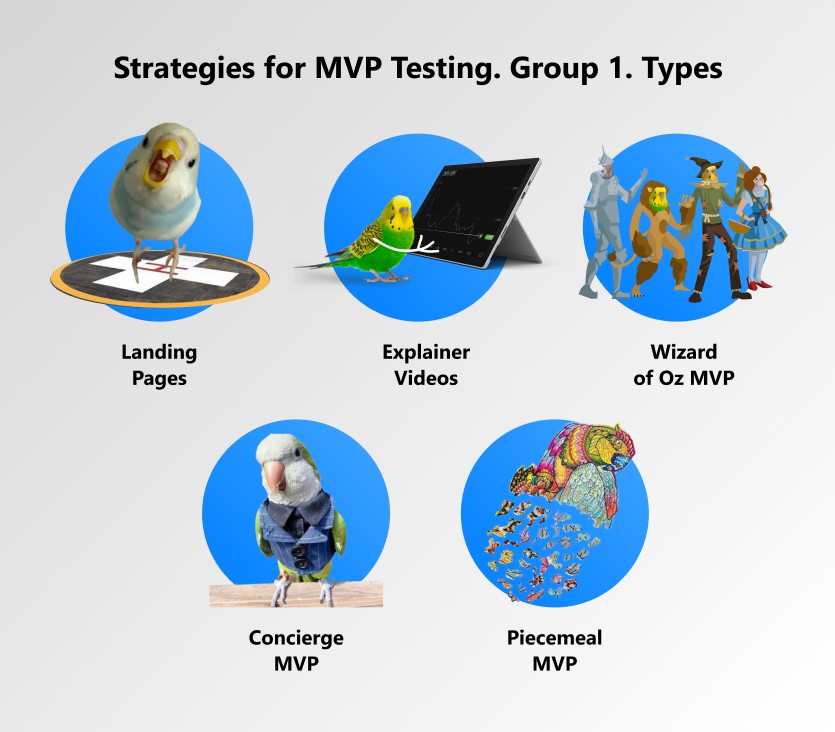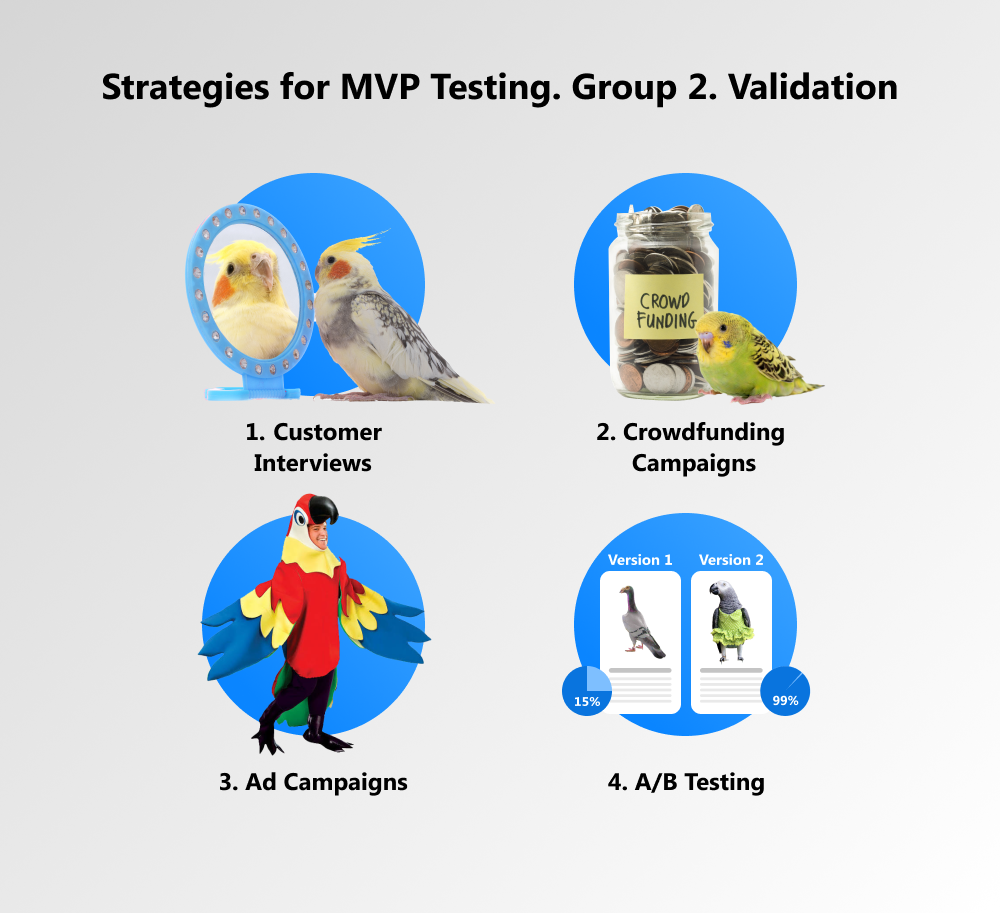According to Steve Blank, who was one of the first to make use of the term, a minimum viable product (MVP) can range from a simple spreadsheet or an early prototype to a fully functioning website or a mobile application, depending on the specific case.
However, no matter the kind of MVP, its goal is always to test the feasibility of the idea and evaluate whether it is worth developing a full-fledged product. As valuable resources and possibly the success of a business as a whole are at stake, it is crucial to gain the maximum in-depth insights from the conducted MVP tests. Hence, in this blog post, we would like to look at some solid tactics for MVP verification.
written by:
Zoya Korol
Senior Software Testing Engineer, Qulix Systems
According to Steve Blank, who was one of the first to make use of the term, a minimum viable product (MVP) can range from a simple spreadsheet or an early prototype to a fully functioning website or a mobile application, depending on the specific case.
Contents
What Is an MVP in Short?
By Eric Ries’ definition, a minimum viable product (MVP) is “the version of a new product that allows a team to collect the maximum amount of validated learning about customers with the least amount of effort”. Even though the validation process is the sole purpose of creating an MVP in the first place, it often gets neglected as product owners are pursuing the idea of cost optimization and a faster way to enter the market, using an MVP as an initial simplified version of their new app or website. Additionally, an MVP is often employed only for validation of the technical feasibility of the product, when it rather should primarily serve as an evaluation of whether it is solving an actual problem of potential users.
At the same time, to ensure acquiring and utilizing enough reliable data from users, it is essential to know the techniques of MVP verification, to understand their purposes, and to be able to choose the right combination of these for testing your specific product.
**To find out more about the idea and benefits of the minimum viable product, have a look at our related blog post here.
Why Validating Your MVP Is Important
Before we deep dive into examples of MVP test techniques, it is first necessary to establish the goals behind the testing process.
Even though it takes less effort to create an MVP than a full-fledged product, it is still extra work and a certain investment of time and money. Hence, its development can only be justified if it serves its purpose of revealing whether it is actually beneficial to further invest into the product’s iteration.
The data required during the MVP validation process is the following:
- hypothetical business viability in a specific market: whether the product is successfully meeting the need in the market and creating value for the users;
- technical & functional product characteristics: even though there is no point in extensively testing a yet unfinished product, there is still a place for user acceptance and product usability testing to check the effectiveness of your preliminary proposition, while still respecting cost limitations.
While there are plenty of strategies for MVP testing, we have selected nine that are proven to work well with most product types and have split them into two groups — MVP types and ways to attract more early users.
Creating the Proposition to Validate
First, it is important to decide how the idea will be presented on the market — a basic but clear proposition to validate. Some examples can be as follows.
1. Landing Pages
A landing page is the first web page a potential customer sees and from which he or she is able to quickly grasp the value proposition and basic information about the product and business. Originally, it has been considered to be a purely marketing tool directed at promoting products and acquiring more subscribers.
However, now it is also seen as a powerful MVP testing platform, as it allows validating the target audience’s interest, product-market fit, and pricing by adding a call for action (e.g. a survey for the preferred price) as well as possibly discovering an additional attracted customer segment.
2. Explainer Videos
The most effective way to vividly present the idea is to demonstrate it rather than describe it, and an explainer video is one of the simpler ways to do so. Besides testing users’ interest in signing up for the product, allowing viewers to leave comments under such video calls for even more valuable insights.
One of the most famous examples of a startup that started with a demo is DropBox. Overnight the number of sign-ups increased from 5,000 to 75,000 people. The video explained Dropbox’s intended functionality and reached target customers who might have not even realized they had a problem in the first place.
3. Wizard of Oz MVP
This approach presents an alternative for those who might not possess enough funds for delivering a complete product or service for market validation from the very start. The idea inspired by the hero of the famous fairytale is to create an illusion of full functionality, while manually performing most of the features behind the scenes or using a set of open-source tools.
Whilst the Wizard of Oz MVP requires significant effort to implement, it also allows first-hand interaction with customers, which is the quickest way to discover their real issues and feedback.
4. Concierge MVP
Similar to the above approach, the Concierge MVP tests the viability of the product by doing the work of features manually. However, the main difference is that customers are aware of that. As this requires a lot of personalized work, this type of the minimum viable product can only be implemented in small batches, providing the product or service only to a small selected privileged group.
Nevertheless, doing work manually and interacting with the clients individually reveals different valuable aspects of customer experience as well as allows collecting reviews and impressions so important at the design stage of the product.
5. Piecemeal MVP
The Piecemeal MVP, a blend of Wizard of Oz and Concierge MVP techniques, is a product demo built by connecting several already existing tools and open-source services. This way, you are able to present your project idea and deliver experience without investing much time or money into building your own product. Once the idea has proven itself, it makes it worth investing in your own unique solution with improved functionalities.
The famous example of the Piecemeal MVP is the e-commerce marketplace Groupon, which initially started as a combination of WordPress, Apple Mail, and AppleScript.
Validating Strategies
Once the MVP has been built, it is time to find some users who would test the product and try to gain as much feedback as possible. This can be done with the help of the following strategies.
1. Customer Interviews
One of the most common and effective ways to validate an MVP is to conduct interviews with customers. However, it is still important to be smart in how you approach your potential users. To encourage unfiltered honest replies, it is best to ask open-ended questions and use improvization rather than pre-written scripts and sales pitches.
In order to get questions right, it is essential to first study the real needs and issues the customer is facing, then offer your solution and let the interviewee express their unbiased opinion and insights on what is missing or could have been done better. The interviews are a gold mine for actionable information that increases your chances to develop the right product or possibly even pivot your offering to reach higher demand.
2. Crowdfunding Campaigns
Crowdfunding campaigns were originally used solely for raising money for a new project. However, today they have also proven to be a great way to test your MVP, as today’s investors are tomorrow’s buyers. In fact, over 6 million projects have been funded through platforms such as Crowdcube in the past year only.
Any type of MVP can be used to describe your business idea on a crowdfunding platform, the major challenge though is that it needs to stand out from millions of others. If the presented idea is successful, you don’t only receive investments for your project, but also get access to a group of interested and actively involved early adopters who are often ready to share their feedback and ideas on how to further improve your product. In addition, you might also discover a new target market in the process.
3. Ad Campaigns
Ad campaigns are another good tool for market research and MVP validation. Platforms like Google and Facebook provide tools for dissecting demographics to the particular target audience and discovering which features or aspects of your product are most appealing to them with the help of indicators like click-through rates, engagement rates, and other conversion metrics. Even though such campaigns will not get your product a lot of exposure, they still give you a priceless chance to test your hypotheses and consumer interest.
Even though ad campaigns are most useful for testing an MVP app or website, it is still possible to utilize them for testing the number of users engaged with a landing page, etc.
4. A/B Testing
Finally, there is also the A/B testing technique that lets user interactions determine which version of your MVP performs best. While some users see one version of the products, others see another and then both groups’ interactions are analyzed and compared with the help of analytical tools such as Google Analytics, Optimizely, etc. that use various indicators like frequency of use, bounce rate, conversion rate and other.
This test works best for evaluating landing pages, ad campaigns, applications, and web pages and allows eliminating the guesswork when it comes to improving the product.
If you would like to find out more MVP testing techniques and get assistance on which ones would work best for your project, please visit our website or get in touch with our support team.

Contacts
Feel free to get in touch with us! Use this contact form for an ASAP response.
Call us at +44 781 135 1374
E-mail us at request@qulix.com











